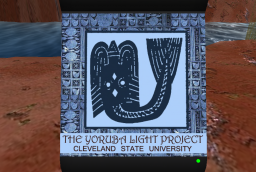
It has begun! (and here begins the catch-up…)
February 13, 2010Several years ago, I was reading the funnies in the newspaper and came upon a reference to Second Life–I’d never heard of it, but I’d had a long interest in the idea of Virtual Worlds, born of exposure to Adobe Atmosphere and games like Myst and The Legend of Lotus Spring (the latter not so great a game, but a jaw-dropping introduction to what could be possible with interactive education). So I merrily registered, immediately thinking, “Ah, some day…some day when I can actually walk and my feet don’t protrude from my shoes, I will figure out a way to use this in class.”
After learning about human interactions and interests as a jazz club hostess at the lamented late Soul Lounge, on Chan Dejavu’s great cultural sim, Dejavu Isles, I got interested in building, and started making clothes. Then came my own cultural homestead sim, Saminaka, a virtual fraction of Nigeria. That taught me plenty about niche interests, ways to open strangers to the wonders of African and diaspora culture and art, and what people wanted to know. We had an African festival and I learned how to make masqueraders on stilts; a friend created a tribute to the Middle Passage, set in the U.S., and I created the African side of the Middle Passage Experience; I tried to create Nigerian regatta canoes and didn’t get far.
But I hungered for an academic sim. And this year I was lucky enough to get a teaching enhancement grant at Cleveland State University. As far as I know, it’s the first full-fledged CSU Second Life project. I’m getting it established this semester with the help of my two classes in African and African American art history, then hope to keep it alive and bring in other disciplines, both within CSU and at collaborative institutions….and expand, of course, to a whole slew of sims!
But here we begin. There is now a (as yet inaccessible) sim entitled Africa Illuminated, and it will host our first over-ambitious effort: The Yoruba Light Project. Whaaaaa? and ?????????
The Yoruba of southwestern Nigeria and an eastern sector of the Republic of Benin are probably the best-studied African ethnic group–whether history, art, religion, oral poetry, music, dance, proverbs, written literature, politics, urban life, agriculture, some prof
essor somewhere in the world has published on it. My interest in the Yoruba sparked my path to the Ph.D.–the whole society is interesting, complex, and has a high fun factor and irresistibility. Due to the transatlantic slave trade, the Yoruba (especially during the inter-kingdom wars of the late 18th and early 19th centuries) ended up in many parts of the Americas. Their cultural stamp in Brazil is clear, as it is in Cuba, in Trinidad, in Haiti, and in the U.S.
More coming on the project and the sim, but here’s the history of the logo–the background shows indigo-dyed Yoruba cloth, or adire, and the foreground shows a mudfish, a frequent motif in Yoruba art. The mudfish, a kind of catfish, can crawl short distances over land or remain still in mud, reviving and scurrying away after a rain. It’s a liminal More coming on the project and the sim, but here’s the history of the logo–the background shows indigo-dyed Yoruba cloth, or adire, and the foreground shows a mudfish, a frequent motif in Yoruba art. The mudfish, a kind of catfish, can crawl short distances over land or remain still in mud, reviving and scurrying away after a rain. It’s a liminal animal, crossing realms of water and earth, and as such is a reminder of travel between worlds. The Yoruba see the barrier between this world and the supernatural world as permeable to specialists. Our Project will send people from one continent to another, as well as zipping through time. So it seems suitable!
//

Leave a comment